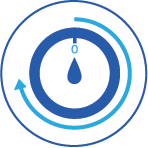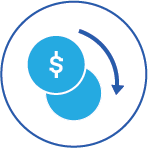How does ConEdison’s net metering work?
ConEdison’s net metering measures the difference between the energy produced by a customer’s own generator (e.g., solar) and the energy that customer uses from ConEdison’s grid. Generating electricity via a solar panel system or another alternative energy source allows customers to transfer any unused electricity back to the grid in exchange for credits on the utility bill. The transfer of energy for credits can help reduce a customer’s monthly electricity bill.
Where does ConEdison offer net metering?
ConEdison’s service territory covers New York City and Westchester County. Net metering is offered to all customers throughout the territory.
What are ConEdison's rates and prices for net metering?
Residential net metering on units less than 50kW (most residential units are less than 20kW) is available through ConEdison’s net metering program. When a customer exports or sends back more energy to the grid than used in a given month, they receive credits valued at the retail price of electricity solar ‘bank’. Net metering credits are rolled over and used to offset usage in months when a customer uses more energy than they generate.
At the end of the year, the remaining solar credits in the ‘bank’ are paid out at the “avoided cost rate.” Avoided cost rate is determined by the average wholesale price for the year increased by 6.6% multiplied by the total number of credits.
For small general units (SC-2) not for residential use along with net metering for solar panel systems for multiple dwellings (SC-8) and general large units (SC-9) not for residential use, there is no annual reconciliation or cashing out of the solar ‘bank’.
For SC-2 customers, net metering credits are applied to future usage. For SC-8 and SC-9 customers, when exports exceed imports for a given month the energy charges are zero and the excess energy is converted to dollars and applied against remaining billing items such as demand charges. Any remaining credits are applied to the next month’s bill as kWh credits.
What is ConEdison’s net metering cap?
In March 2017, the net metering cap for New York State transitioned away from peak load calculations to 2% of each utility’s incremental net revenue. The Public Service Commission requires each utility to report when they reach 85% of the recommended net metering capacity so subsequent action can be determined. 2% of ConEdison’s net annual revenue is 90MW meaning that the 85% capacity marker is set at 76.5MW.
| State | Cap (%) | Cap (MW) |
|---|---|---|
| New York | 2% net annual revenue (90MW) | 76.5MW (warning, not cap) |
Is ConEdison net metering the best in New York City and Westchester County?
ConEdison is the main electrical utility for New York City save for some parts of Brooklyn, which are covered by National Grid. As National Grid only serves the Rockaways, for most New York City customers, ConEdison is the only utility and is the best for net metering by default. Some residents in Westchester County may also have access to NYSEG but this utility does not have a robust solar panel system net metering program and offers about one-fifth the MW capacity of ConEdison. Based on this comparison, ConEdison is the best solar panel system net metering option for Westchester residents.
What will happen to my ConEdison net metering bill credits?
Net metering credits appear on a ConEdison customer’s bill when the amount of energy sent back to the grid is greater than the energy used from the grid in a given month. Monthly charges are reduced to zero with the bill only reflecting the basic service charge (around $20) and the excess kWh generated are rolled over to the next month as credit in a solar ‘bank’.
In months when a customer uses more energy than generated, these credits are applied to that month’s bill. Once annually, the unused credits are converted to a dollar amount at avoided cost rate. Avoided cost rate is determined by the average wholesale price for the year increased by 6.6% (about 10 cents/kWh) multiplied by the total number of credits in a customer’s solar ‘bank’ at the end of the year. If the total exceeds $100, ConEdison will issue the customer a check and for amounts less than $100, the monetary credit is applied to the bill.
For ConEdison customers that are not small residential, there is no cashing out of the solar ‘bank’ at the end of the year. Instead, these credits apply to future usage (SC-2) . For SC-8 and SC-9 customers, the excess energy generated is converted to dollars and applied against remaining billing items such as demand charges. Any remaining credits are applied to the next month’s bill as kWh credits.
Does ConEdison offer other solar incentives?
ConEdison works with the NY-Sun Initiative’s Megawatt Block program, which provides rebates and performance incentives for New York residents who install solar panel systems. The Megawatt Block Incentive Structure is one of New York’s most important solar incentives that provides generous up-front discounts for both commercial and residential solar panel systems. The discounts are delivered in a dollar per watt format with the incentive rate determined by the region’s current Block (ConEdison has its own region).
Blocks work by offering a specific incentive amount until the MW limit is reached, at which point the next Block begins with a different (lower) incentive rate. As of early 2020, ConEdison residential customers are currently filling Block 9, meaning the current incentive is $0.20/watt with a cap of 120MW. ConEdison nonresidential customers are currently filling Block 9, which has an incentive rate of $0.30/watt. This block has a cap of 70MW. As incentive prices will continue to decrease, now is a great time to consider installing a solar panel system!
Learn more about Megawatt Block and other New York rebates & incentives with EnergySage’s New York Solar Incentives guide.
ConEdison solar interconnection policies and costs
ConEdison adheres to the Standardized Interconnection Requirements (SIR) for New York State and draws a distinction between solar panel systems greater than and less than 50 kW (most residential systems are less than 25 kW). For systems less than 50 kW, ConEdison has implemented an expedited process, which includes self-certification by the customers.
Self-certification means that ConEdison does not do a lengthy review of the project and instead reviews a simple application ensuring compliance and proper documentation before the system can be built followed by an inverter test and the submission of the self-certification form. At this point, ConEdison performs their final review, places the net meter order, and issues the final acceptance letter. The aim of self-certification is to get small residential projects through the interconnection process faster and more efficiently.
Looking for the best solar companies in Consolidated Edison (ConEd, Con Edison) territory?
You wouldn’t buy a car without comparing a few options first.Shouldn’t solar be the same?
Compare multiple solar quotes on EnergySage
With EnergySage, you can compare your solar options when you
receive quotes from the best local solar installers near you.
Get a quick estimate of your savings with solar
Find out how affordable solar is for your home with our Solar Calculator, or simply register your property today to get quotes.








